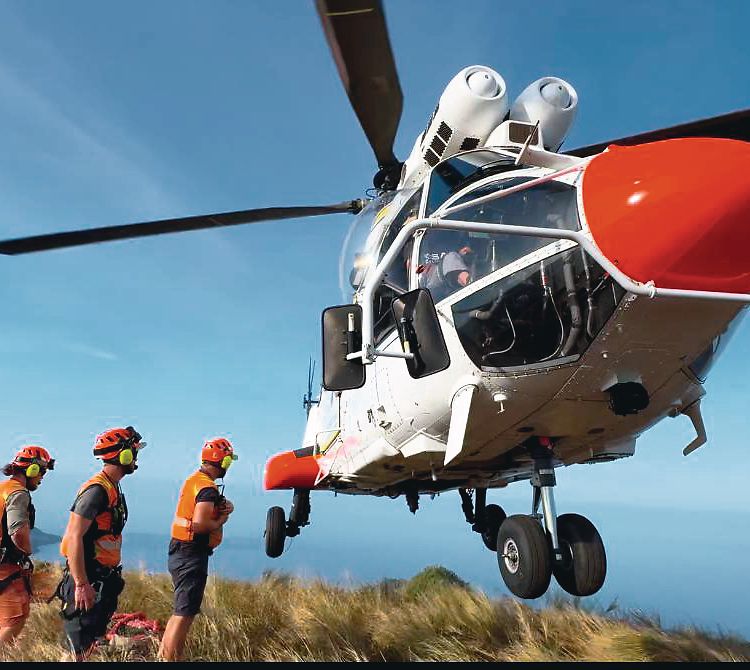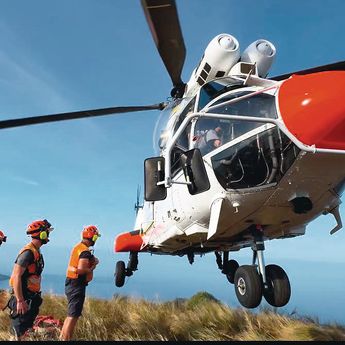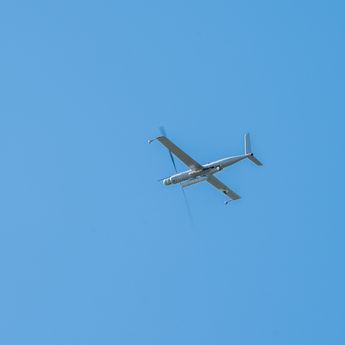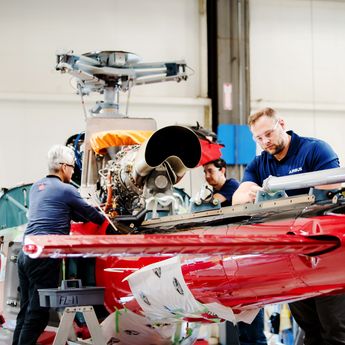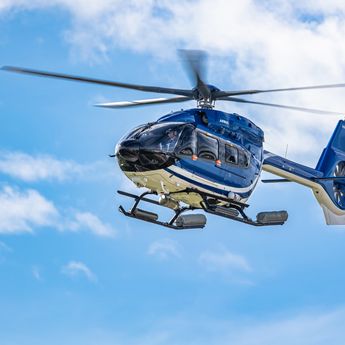In mid-December 2024, Cyclone Chido unleashed its fury on Mayotte, a French overseas department located in the Mozambique Channel off Africa’s east coast. The storm plunged 320,000 residents into darkness, leaving many without water and flattening the homes of countless families. The need for immediate aid and infrastructure restoration was critical.
Just days later, Jean-Louis Camus, co-CEO of SAF Aerogroup, received an urgent call from France’s Direction Générale de la Sécurité Civile et de la Gestion des Crises (Department of Civil Security and Crisis Management). The expertise of SAF Hélicopères (a division within SAF Aerogroup that focuses on aerial work and helicopter emergency medical services) was desperately needed to deliver vital supplies and begin the monumental task of rebuilding. This challenging mission not only highlighted aviation’s essential role in times of crisis but also saw one of SAF’s Super Pumas become the first civil helicopter ever transported by an A400M, a remarkable feat that enabled rapid response to a desperate situation.

Exceptional missions - worldwide
SAF Aerogroup’s operational footprint is global, spanning Europe, Africa, the Indian Ocean and South America. Its core values and expertise remain consistent. Indeed, with a strong focus on helicopter emergency medical services (HEMS), mountain rescue, fighting forest fires and humanitarian or logistics missions, SAF were as prepared as it is possible to be for the challenging conditions of Mayotte. Add in the group’s in-house light and heavy vertical lift expertise, maintenance capabilities and training centre and you can understand why its operational quality, efficiency and overall readiness are frequently sought by the Ministry of Interior and other governmental agencies. “We perform exceptional missions every day to help people and protect the environment,” explains Camus. “And these are particularly complex missions. They require a 24/7 presence, an ability to take off 24 hours a day, day or night, all year round and possibly in harsh environments. We are obliged to take off within three to five minutes for each mission.” Ensuring this presence depends on the work of the aforementioned in-house maintenance team, a team which – judging by its near 100% availability in France and over 95% availability commitment on coming missions in Greece – is doing sterling work.
Increasing pressure
Camus points out some of the challenges that the SAF Hélicoptères team was operating under. “You can imagine the urgency of the situation, which creates a certain pressure,” he states. “You can also understand the logistical complexity of transporting a helicopter using an aircraft like the A400M, and then the local pressure because people are waiting for rescue and support.” Only four days elapsed between SAF receiving the call on 24 December and the unprecedented event of a civil Super Puma being loaded onto the A400M. Perhaps nobody in the world is as well-placed to comment on this particular mix of civil and military for an operation as Camus, a man who has both flown the H215M Cougar for the French military and who was also responsible for designing the A400M cockpit during part of his career with Airbus. “The A400M was the only aircraft that could land in Mayotte right after the cyclone,” says Camus. “It is a formidable aircraft. We coordinated our discussions with the Ministry of Interior and Civil Security and the Ministry of Armed Forces, and were supported by Airtelis (our partners in firefighting in France for the Sécurité Civile) for helicopter transport, to be able to effectively load the Super Puma into the A400M. This loading took place on 28 December, and then we departed for Djibouti and Mayotte. We reassembled the helicopter in Mayotte and began operations on 1 January.”

In addition to the Super Puma, the A400M brought everything the SAF crew would need to complete the various missions they would be flying. “We brought more than 10 tonnes of freight to the site,” explains Camus. “In particular, all the equipment that enables crews to be in full autonomy and that allowed the Super Puma to carry out all its missions: rescuing citizens, rebuilding work, carrying out emergency reconstruction, and in particular, clearing containers that had been blown away by the cyclone, which were threatening residents in the centre of town. Thanks to our high-precision lifting skills, we restored the telephone network by rebuilding telephone antennae, and we even carried out firefighting at the end of the mission.

All the equipment which the H215 needed for this, was loaded onto the A400M for deployment.” The operation necessitated huge efforts from SAF’s crew in terms of preparing the H215 for transport, reassembling it and providing continuous support in challenging conditions throughout the operation. During their time in Mayotte, the crew had to be completely self-sufficient, sleeping under mosquito nets and eating rations on a tropical island that had just been devastated by a cyclone. The team also faced other numerous challenges operating in a disaster area, as Camus attests: “Our teams faced difficulties with meteorological conditions; the weather was extremely hot, extremely humid and we also experienced a storm after the cyclone where we had to take refuge in the Comoros before returning to operate. There were also communication challenges. All telephone networks were down, and in such a complex operation, maintaining links [with other mission stakeholders] is crucial. The coordination was particularly key with the Sécurité Civile teams, who did a remarkable job on site, as well as with the Prefecture, the Gendarmerie and the Army, with whom we worked in complete coordination on site. Also, from a mechanical point of view, the helicopter was subjected to extreme conditions of temperature, a saline environment and so, mechanically, it was also a complicated job to carry out.”

The Airbus H215: An exceptional machine
In the face of these myriad challenges, SAF’s Super Puma was a vital tool during their missions in Mayotte. Though Camus did not fly it during this deployment, his time flying it in the French army has left him with an enduring respect for the Cougar. “It’s an exceptional machine for several reasons,” he states, “The first is its ability to perform multiple missions, which makes it an ideal helicopter to use in the field. You saw in Mayotte; the entire range of missions could be carried out in one month. It is also an extremely high-performing machine in terms of power and endurance, and it is a particularly reliable machine.”
Amongst the various operations the H215 could perform is one in particular that SAF believes is absolutely critical during disaster relief missions—its rare high-precision lifting capability. “In addition to rescue operations, precision lifting allows us to drop a load without having to secure a football field, for example, because we operate with very long slings and are high enough to drop our loads anywhere, for instance, close to homes, without significant downwash on the ground. This capability allowed us to deliver food and water to any point on the island, in coordination with the Sécurité Civile. It also allowed us to rebuild the telephone network with the ability to lift and re-erect antennae. 80% of the telephone network was back in operation in two days. Our H215 was 100% available during this mission.”

Having accomplished so much, it is no wonder that Camus is proud of the work that his crew and engineers performed to bring vital aid. “This mission demonstrated that, in coordination with the Sécurité Civile, we are capable of providing rescue and support anywhere in France, in Europe or in overseas territories with an exceptional transport capability, thanks to the A400M.” SAF Hélicoptères’s use of its Super Puma in Mayotte is the perfect proof of the value of versatile platforms to support local populations in the aftermath of a natural disaster. “In one month, we performed approximately 70 flight hours,” says Jean-Louis Camus. “It takes fifteen minutes for the Super Puma to cross the island of Mayotte, so you can imagine the number of missions we carried out there.”
